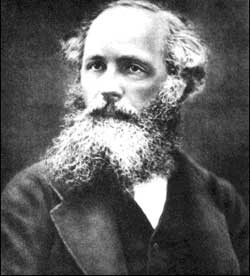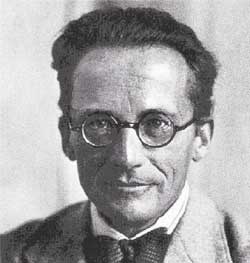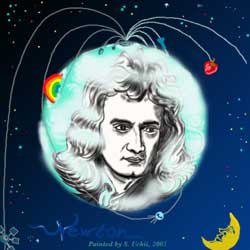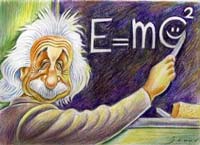Readers of Physics World magazine have voted for their favorite equations of all time. But what do they mean? The magazine’s deputy editor, Dr. Matin Durrani, has provided a simple guide to the top five equations.
1. Tied for First – Maxwell’s Equations
∇·D = p
∇·B = 0
∇×E = -∂B/∂t
∇×H = ∂D/∂t + j
 |
James Clerk Maxwell (Image: dbhs.wvusd) |
In these equations, D is the displacement field, E is the electric field, B is the magnetic flux density, H is the magnetic field strength, p is the free charge density, and j is the free current density.
This formula was written by the famous Scottish physicist James Clerk Maxwell in 1873. It describes how an electromagnetic wave—such as a beam of light, an X-ray, or a microwave—varies in space and time.
The interesting thing about this equation is that it shows that electric fields and magnetic fields—two types of fields that scientists previously thought had no relation to each other—are actually closely linked. Following this discovery, physicists continued to connect electromagnetic forces with two other fundamental forces of nature: the strong nuclear force and the weak nuclear force, which interact within the atomic nucleus.
The result of this hypothesis is known as the Standard Model of particle physics. The biggest challenge now for scientists is to determine whether gravity—the fourth fundamental force—is related to this model. Thus, Maxwell was essentially the first physicist to unify the forces of nature into a single theoretical framework.
Maxwell’s equations are widely used in the telecommunications industry, for instance, to design antennas for your mobile phone.
2. Tied for First – Euler’s Equation
eiπ + 1 = 0
This equation was discovered by Swiss mathematician Leonhard Euler in the 18th century. Physicists favor this equation because it encapsulates nine fundamental concepts of mathematics into a single formula.
These nine concepts include: pi, which is the circumference of a circle divided by its diameter; i, the square root of -1; and e, approximately equal to 2.71828. The remaining six concepts are multiplication, addition, equality, one, zero, and “exponentiation.”
What is the use of this equation? Nothing at all. Euler’s formula is purely a mathematical statement with no obvious real-world applications, although some physicists consider it to be “beautiful.”
My personal prediction: It will be present in the unified theory!
3. Newton’s Second Law
Isaac Newton (Image: bun.kyoto-u.ac)
F = ma
This formula describes the reality that if you apply a force (F) to an object with mass (m), that object will experience an acceleration (a). The equation was formulated by Isaac Newton in the late 17th century.
What is the benefit of this equation? Newton’s second law can explain how your new Mini Cooper can accelerate from 0 to 60 miles per hour. And simply put, you need to remember it for your 10th-grade physics homework on dynamics unless you want to face the consequences!
4. Pythagorean Theorem
a² + b² = c²
A beloved school formula. The Pythagorean theorem explains the relationship between the sides of a right triangle. If a and b are the lengths of the two legs, and c is the length of the hypotenuse, this formula was described by the ancient Greek scientist Pythagoras in the 6th century BC.
What is the application of this equation? The Pythagorean theorem aids in triangulation, helping to pinpoint someone’s location using a mobile phone based solely on feedback signals from three different cell towers.
5. Schrödinger’s Equation
HΨ = EΨ
 |
| Austrian physicist Erwin Schrödinger (Image: physics) |
This formula was written by Austrian physicist Erwin Schrödinger in the mid-1920s. It describes the motion of subatomic particles (such as electrons) and is foundational to quantum physics.
With small particles like electrons, you cannot precisely determine their position in space as well as their speed. All you can do is hypothesize where they are at any given time. The symbol Ψ in the equation is referred to as the “wave function”—it describes the probability of a particle existing at different points in space.
What is the benefit of this equation? Schrödinger’s equation has numerous applications in electronic devices. For example, Quantum Beam Company in Cambridge uses it to build laser-based systems that connect your home computers to the Internet without wires. Someone once said: Solid-state people use this equation to do everything: from nanotechnology to low-dimensional systems to new materials.
6. Einstein’s Equation
E = mc²
Albert Einstein (Image: krux)
This famous equation by Einstein shows that mass and energy are interchangeable. If an object has mass (m), it will have rest energy given by E=mc², where c is the speed of light. Since c is extremely large—about 300,000 km/s—even the smallest objects have significant rest energy.
Conversely, energy also has mass. You may hear a lot about this equation in 2005, during the centenary of Einstein discovering it as part of his theory of relativity.
What is the benefit of this equation? E=mc² determines the amount of energy released when atoms are split in nuclear power reactors. In nuclear reactions, mass is not conserved. A portion of the mass is lost, which instead generates enough energy for nuclear power plants and is also the reason for the disasters in two Japanese cities due to the atomic bombs dropped by the U.S. after World War II.




















































